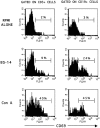Activation of IL-10+ B cells: A novel immunomodulatory mechanism for therapeutic bacterial suspensions
- PMID: 32002185
- PMCID: PMC6963315
- DOI: 10.1177/2050312120901547
Activation of IL-10+ B cells: A novel immunomodulatory mechanism for therapeutic bacterial suspensions
Abstract
Objectives: Bacterial components are used to improve immune responses in patients with respiratory infections. Pharmacological formulations of bacterial components include a mixture of bacterial antigens, some of which are complete inactivated bacteria, that is, named bacterial suspensions; while others are fragments of bacteria, which are presented as bacterial lysates. Although bacterial lysates have been broadly used as immune-stimulators, the biological support for the therapeutic effectiveness of bacterial suspension has not yet been studied. Thus, the aim of our study was to investigate the immunological activity induced by bacterial suspension.
Methods: This work was an exploratory translational study. Peripheral blood mononuclear cells were obtained from healthy donors and cultured in time-dose dependent assays with a commercial bacterial suspension. Flow cytometry was used for phenotypic analysis and for determining soluble cytokines in culture supernatants.
Results: We observed that bacterial suspension activates B cells in a dose-dependent manner. Peripheral blood mononuclear cells were able to secrete IL-6 and IL-10 after 24 h of bacterial suspension stimulation. TLR2 expression was observed mainly on CD19+ CD38Lo B cells after 72 h of culture; remarkably, most of the TLR2+ CD19+ cells were also IL-10+.
Conclusion: Our findings suggest that bacterial suspension induces the activation of B cell subsets as well as the secretion of IL-6 and IL-10. Expression of TLR2 on CD19+ cells could act as an activation loop of IL-10+ B regulatory cells. The clinical implications of these findings are discussed at the end of this article.
Keywords: B cells; Bregs; IL-10; IL-6; bacterial suspension; immunomodulation.
© The Author(s) 2020.
Conflict of interest statement
Declaration of conflicting interests: The author(s) declared no potential conflicts of interest with respect to the research, authorship, and/or publication of this article.
Figures





Similar articles
-
Comparison of peripheral blood B cell subset ratios and B cell-related cytokine levels between ocular and generalized myasthenia gravis.Int Immunopharmacol. 2020 Mar;80:106130. doi: 10.1016/j.intimp.2019.106130. Epub 2020 Jan 21. Int Immunopharmacol. 2020. PMID: 31978800
-
Decreased IL-10-producing regulatory B cells in patients with advanced mycosis fungoides.Eur J Dermatol. 2018 Jun 1;28(3):314-319. doi: 10.1684/ejd.2018.3319. Eur J Dermatol. 2018. PMID: 29952298
-
IL-10-producing regulatory B-cells suppressed effector T-cells but enhanced regulatory T-cells in chronic HBV infection.Clin Sci (Lond). 2016 Jun 1;130(11):907-19. doi: 10.1042/CS20160069. Epub 2016 Mar 15. Clin Sci (Lond). 2016. PMID: 26980345
-
Altered B lymphocyte homeostasis and functions in systemic sclerosis.Autoimmun Rev. 2018 Mar;17(3):244-255. doi: 10.1016/j.autrev.2017.10.015. Epub 2018 Jan 16. Autoimmun Rev. 2018. PMID: 29343447 Review.
-
Regulatory B and T cell responses in patients with autoimmune thyroid disease and healthy controls.Dan Med J. 2016 Feb;63(2):B5177. Dan Med J. 2016. PMID: 26836805 Review.
Cited by
-
Immune Response against Adenovirus in Acute Upper Respiratory Tract Infections in Immunocompetent Children.Vaccines (Basel). 2020 Oct 13;8(4):602. doi: 10.3390/vaccines8040602. Vaccines (Basel). 2020. PMID: 33066100 Free PMC article.
References
-
- Cazzola M, Anapurapu S, Page CP. Polyvalent mechanical bacterial lysate for the prevention of recurrent respiratory infections: a meta-analysis. Pulm Pharmacol Ther 2012; 25(1): 62–68. - PubMed
-
- Ricci R, Palmero C, Bazurro G, et al. The administration of a polyvalent mechanical bacterial lysate in elderly patients with COPD results in serological signs of an efficient immune response associated with a reduced number of acute episodes. Pulm Pharmacol Ther 2014; 27(1): 109–113. - PubMed
-
- Lanzilli G, Traggiai E, Braido F, et al. Administration of a polyvalent mechanical bacterial lysate to elderly patients with COPD: effects on circulating T, B and NK cells. Immunol Lett 2013; 149(1–2): 62–67. - PubMed
-
- Rial A, Ferrara F, Suarez N, et al. Intranasal administration of a polyvalent bacterial lysate induces self-restricted inflammation in the lungs and a Th1/Th17 memory signature. Microbes Infect 2016; 18(12): 747–757. - PubMed
LinkOut - more resources
Full Text Sources
Research Materials

